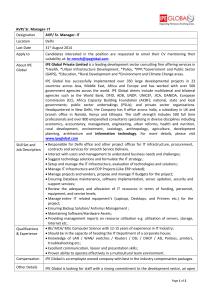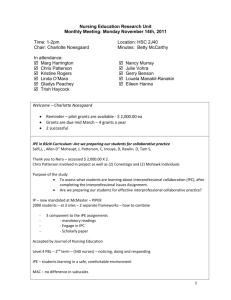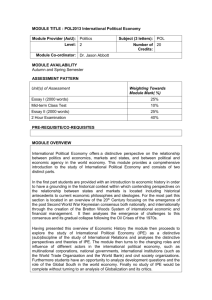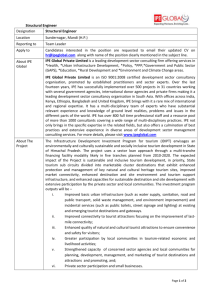Theoretical analysis and experimental verification of moment
advertisement
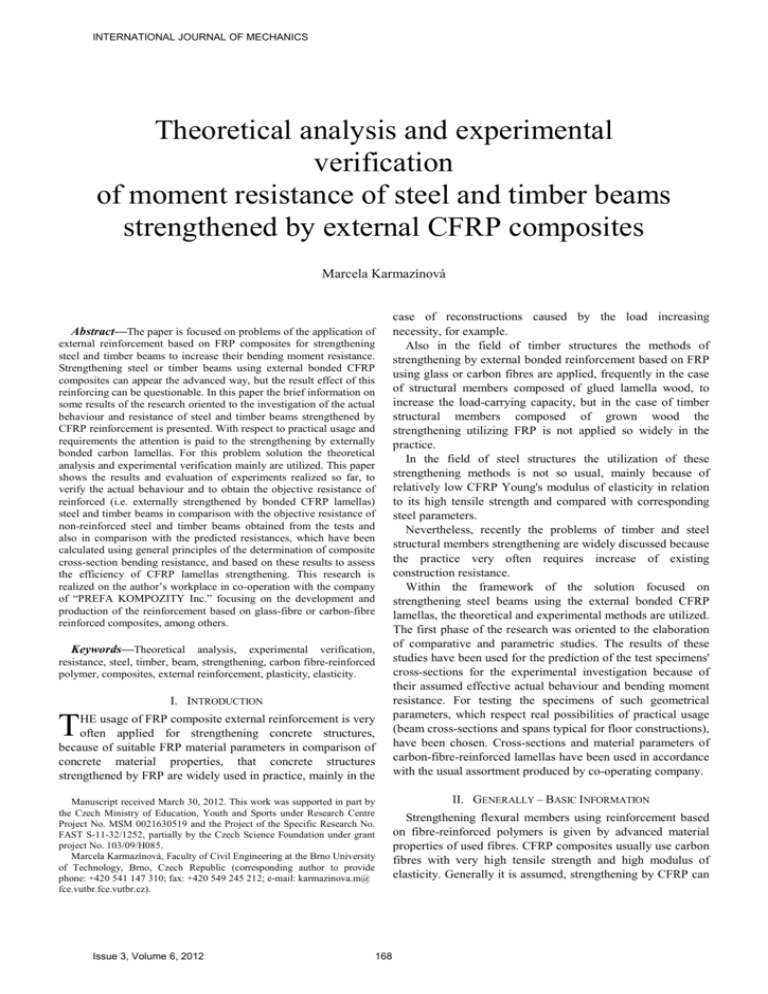
INTERNATIONAL JOURNAL OF MECHANICS Theoretical analysis and experimental verification of moment resistance of steel and timber beams strengthened by external CFRP composites Marcela Karmazínová Abstract—The paper is focused on problems of the application of external reinforcement based on FRP composites for strengthening steel and timber beams to increase their bending moment resistance. Strengthening steel or timber beams using external bonded CFRP composites can appear the advanced way, but the result effect of this reinforcing can be questionable. In this paper the brief information on some results of the research oriented to the investigation of the actual behaviour and resistance of steel and timber beams strengthened by CFRP reinforcement is presented. With respect to practical usage and requirements the attention is paid to the strengthening by externally bonded carbon lamellas. For this problem solution the theoretical analysis and experimental verification mainly are utilized. This paper shows the results and evaluation of experiments realized so far, to verify the actual behaviour and to obtain the objective resistance of reinforced (i.e. externally strengthened by bonded CFRP lamellas) steel and timber beams in comparison with the objective resistance of non-reinforced steel and timber beams obtained from the tests and also in comparison with the predicted resistances, which have been calculated using general principles of the determination of composite cross-section bending resistance, and based on these results to assess the efficiency of CFRP lamellas strengthening. This research is realized on the author’s workplace in co-operation with the company of “PREFA KOMPOZITY Inc.” focusing on the development and production of the reinforcement based on glass-fibre or carbon-fibre reinforced composites, among others. Keywords—Theoretical analysis, experimental verification, resistance, steel, timber, beam, strengthening, carbon fibre-reinforced polymer, composites, external reinforcement, plasticity, elasticity. I. INTRODUCTION T HE usage of FRP composite external reinforcement is very often applied for strengthening concrete structures, because of suitable FRP material parameters in comparison of concrete material properties, that concrete structures strengthened by FRP are widely used in practice, mainly in the Manuscript received March 30, 2012. This work was supported in part by the Czech Ministry of Education, Youth and Sports under Research Centre Project No. MSM 0021630519 and the Project of the Specific Research No. FAST S-11-32/1252, partially by the Czech Science Foundation under grant project No. 103/09/H085. Marcela Karmazínová, Faculty of Civil Engineering at the Brno University of Technology, Brno, Czech Republic (corresponding author to provide phone: +420 541 147 310; fax: +420 549 245 212; e-mail: karmazinova.m@ fce.vutbr.fce.vutbr.cz). Issue 3, Volume 6, 2012 168 case of reconstructions caused by the load increasing necessity, for example. Also in the field of timber structures the methods of strengthening by external bonded reinforcement based on FRP using glass or carbon fibres are applied, frequently in the case of structural members composed of glued lamella wood, to increase the load-carrying capacity, but in the case of timber structural members composed of grown wood the strengthening utilizing FRP is not applied so widely in the practice. In the field of steel structures the utilization of these strengthening methods is not so usual, mainly because of relatively low CFRP Young's modulus of elasticity in relation to its high tensile strength and compared with corresponding steel parameters. Nevertheless, recently the problems of timber and steel structural members strengthening are widely discussed because the practice very often requires increase of existing construction resistance. Within the framework of the solution focused on strengthening steel beams using the external bonded CFRP lamellas, the theoretical and experimental methods are utilized. The first phase of the research was oriented to the elaboration of comparative and parametric studies. The results of these studies have been used for the prediction of the test specimens' cross-sections for the experimental investigation because of their assumed effective actual behaviour and bending moment resistance. For testing the specimens of such geometrical parameters, which respect real possibilities of practical usage (beam cross-sections and spans typical for floor constructions), have been chosen. Cross-sections and material parameters of carbon-fibre-reinforced lamellas have been used in accordance with the usual assortment produced by co-operating company. II. GENERALLY – BASIC INFORMATION Strengthening flexural members using reinforcement based on fibre-reinforced polymers is given by advanced material properties of used fibres. CFRP composites usually use carbon fibres with very high tensile strength and high modulus of elasticity. Generally it is assumed, strengthening by CFRP can INTERNATIONAL JOURNAL OF MECHANICS be more efficient for timber than steel. To compare the results and to evaluate the reinforcing effectiveness, the research is more widely focused on timber beams and steel beams strengthening, too. To strengthen steel bending structural members, carbon fibres could be efficient because of their very high tensile strength (thousands MPa), even several times higher than steel strength, but their Young's modulus of elasticity is usually less than Young's modulus of steel. Depending on the production technology, if tensile strength is increasing, then modulus of elasticity is decreasing usually, regardless of the high price of high Young's modulus carbon fibres. So that, though carbon fibre tensile strength can be much higher than steel tensile strength, the modulus of elasticity usually does not reach the value of steel modulus of elasticity. Within the framework of the research oriented to the strengthening steel and timber beams using the external bonded FRP reinforcement, the theoretical and experimental methods of the solution are utilized. The first phase of the research was directed towards the elaboration of comparative and parametric studies. The results of these studies have been used for the prediction of the test specimens’ cross-sections available for the experimental investigation of the actual behaviour and bending resistance. For the test specimens such mechanical and geometrical parameters, which respect real possibilities of practical usage, have been chosen; that means the beams cross-sections and spans have been considered as typical for the beams of floor structures. Cross-sections and material parameters of carbon-fibre-reinforced lamellas have been used in accordance with the usual assortment produced by co-operating company. A. Theoretical Analysis of Bending Moment Resistance To predict the bending moment resistance, both elastic and plastic approaches have been considered for both type of the beams, that means for steel and timber beams, too. σ1 Fig. 2 concept of the moment resistance calculation – stress distribution: plastic principle In the case of timber beams strengthened by CFRP external reinforcement, the same principles can be used. But here the Young's modulus of elasticity of CFRP is very high compared to Young's modulus of timber, as well as the strength. Then the modulus and strength of CFRP cannot be enough utilized by the elastic behaviour, so that here the elastic approach also does not give the important resistance increasing. The plastic approach only gives the significant increase of the resistance, but tests shown (see below) the actual resistances do not reach by far these values. On that account for the calculation of the timber beams resistance the partial plastic approach neglecting the tensile part of timber beams has been applied (see below). For the calculation of assumed resistances basic principles mentioned above in accordance with [1], [2], [3], [4], [7] have been used. Practically the bending moment resistance has been calculated using [24], [25], [26]. B. Experimental Verification of Bending Moment Resistance The test specimens (steel and timber ones too) have been simply supported and loaded by forces in the beam thirds. σ2 σ3 Fig. 1 concept of the moment resistance calculation – stress distribution: elastic principle – σ3 > σ2 in the case of Ef > Es only For the calculation of the predicted elastic bending moment Issue 3, Volume 6, 2012 resistances the concept of the composite cross-section has been applied (see e.g. [1], [2], [24]), that means the substitute crosssection based on the parameter n = Es / Ef, where Es, Ef are Young's modulus of elasticity of steel beam and CFRP reinforcement, is used. The high strength of CFRP polymer can be effectively utilized if Ef > Es, because in such a case only the stress σ3 in CFRP is more than the stress σ2 (σ3 > σ2) in the bottom flange of steel beam – see Fig. 1. If Young's modulus of CFRP is less than Young's modulus of steel, the elastic approach does not give moment resistance increasing. Then the plastic approach only is efficient from the viewpoint of the moment resistance increasing – see Fig. 2. 169 INTERNATIONAL JOURNAL OF MECHANICS Fig. 1 tested specimen static scheme: four-points bending The force F applied by hydraulic jack has been introduced to the beam through the stiff steel girder, so that the values of the forces acting in the span thirds were F/2. During loading process, the forces F, deflections w at a mid-span and the stresses on the tensile beam edge have been measured through the strain gauges. The same test set-up, in principle, has been used in the case of all specimens. IPE 140 IPE 140 1 IPE 120 IPE 120 1 IPE 140-C 1 IPE 140-C 2 IPE 140-C 3 IPE 120-C 1 IPE 120-C 2 IPE 120-C 3 So far 15 steel beams (cross-sections IPE 200, IPE 180, IPE 160, IPE 140, IPE 120 – 3 specimens for each group) strengthened by CFRP lamellas and 7 non-strengthened steel beams (the same cross-sections – 1 specimen for each crosssection) have been tested. The overview of the specimens tested so far is shown in Table I. The actual values of material parameters of steel beams – yield strength and Young's modulus of elasticity (for each section separately) have been measured and are viewed in Table II. Table II Mechanical properties of steel III. STEEL BEAMS STRENGTHENED BY CFRP Respecting these conditions given above, for the first phase of the experimental verification of CFRP strengthened steel beams test specimens with following material and geometrical parameters have been chosen: (i) steel beams – for steel beams IPE hot-rolled members with the dimensions of IPE 200, IPE 180, IPE 160, IPE 140, IPE 120 have been used; two beam spans in dependence of cross-section dimensions were used – L = 4 m (IPE 200, IPE 180, IPE 160) and L = 3 m (IPE 140, IPE 120); steel grade S 235 (actual properties have been measured – see below); (ii) carbon-fibre-reinforced-polymer composite – the crosssection of CFRP lamellas was 50 x 1.2, tensile strength was of 3 000 MPa, Young's modulus of 155 GPa. A. Test Specimens, Test Arrangement, Test Performance For the experimental verification the predicted resistance calculation has been performed. At first the preliminary calculation of the elastic resistance moment for strengthened beam of IPE 200 section was made, but for considered steel cross-section and CFRP reinforcement practically no increase of the bending moment resistance occurred. The calculation for other cross-sections (IPE 180, IPE 160, IPE 140, IPE 120) confirmed, that the elastic behaviour gives no significant resistance increasing, hence the plastic behaviour only can give required reserve and significant resistance increasing. Steel cross-section Yield strength fy [MPa] Young's modulus Es [GPa] IPE 200 302.0 193.0 IPE 180 315.4 209.4 IPE 160 290.0 202.0 IPE 140 347.5 215.0 IPE 120 344.7 206.2 One of the specimens without CFRP lamella (IPE 200) was loaded very speedily because of the test equipment defect, so that this result is not relevant and was not considered to the evaluation. The behaviour of one of the first test specimens (IPE 200) has been influenced by lateral buckling (see Fig. 8). But this problem has not been solved here and for the next specimen testing the test set-up has been completed adding horizontal supporting to eliminate lateral buckling effect. Table I Overview of tested specimens: steel beams Steel cross-section IPE without CRP IPE with CFRP IPE 200 IPE 200 1 IPE 200 2 IPE 200 3 IPE 180 IPE 180 1 IPE 160 IPE 160 1 IPE 200-C 1 IPE 200-C 2 IPE 200-C 3 IPE 180-C 1 IPE 180-C 2 IPE 180-C 3 IPE 160-C 1 IPE 160-C 2 IPE 160-C 3 Issue 3, Volume 6, 2012 Fig. 4 test arrangement and realization – steel beams with CFRP 170 INTERNATIONAL JOURNAL OF MECHANICS beams) calculated based on the theoretical analysis (for more see above) for measured properties are illustrated. The overview of the bending moment resistances Mu,exp obtained from the tests and their comparison with predicted values Mu,el, Mu,pl calculated based on the elastic and plastic behaviour is shown in Table III. The calculations (see e.g. [8], [10], [14] and below) indicated that plastic bending moment resistances of CFRP strengthened beams in comparison with elastic moment resistances should be about by 35 % (IPE 200) up to 45 % (IPE 120) higher and should have the increasing trend with the cross-section height decrease. However, the tests show that the actual bending moment resistances of strengthened beams practically reach the values of elastic moment resistances or are higher by from 0 % to 15 % usually and have the decreasing trend with the cross-section height decrease. Probably it is caused due to the better activation of CFRP lamellas bonded on the higher beams than lower ones, because of the height and stiffness of the beam. Fig. 5 test realization – steel beams with CFRP: load introducing to the specimen through the stiff girder 80 70 lateral buckling 60 Fig. 6 strain gauges on bottom flange of steel beam and on CFRP 50 40 30 20 IPE 200 1 IPE 200 2 IPE 200-C 1 - lateral buckling 10 IPE 200-C 2 M [kNm] IPE 200-C 3 Fig. 7 typical failure of CFRP strengthened steel beam Illustrations of the tests arrangement and realization are shown in Figs. 4 and 5, the strain and failure mechanisms of test specimens are seen in Fig. 7, as well as CFRP lamella and strain gauge of the bottom flange in Fig. 6. IPE 200-C: Mu,el = 59.14 kNm 0 0 20 40 60 80 100 120 w [mm] Fig. 8 “Mu,exp – w” diagrams for IPE 200: experiment vs. calculation B. Test Results Graphs in Figs. 8, 9, 10, 11, 12 present “M – w” diagrams, i.e. relation between moments Mu,exp and deflections w in the mid-span for all 22 tested specimens (without and with CFRP strengthening). For each cross-section always 3 tests of CFRP strengthened beam and 1 test of non-strengthened beam have been performed, for the comparison. In graphs the objective ultimate bending moments Mu,exp from the tests in comparison with the moment resistances Mu,el, Mu,pl (for strengthened steel Issue 3, Volume 6, 2012 IPE 200-C: Mu,pl = 79.95 kNm 171 INTERNATIONAL JOURNAL OF MECHANICS 70 40 60 30 50 20 IPE 140 1 40 IPE 140-C 1 IPE 140-C 2 10 M [kNm] IPE 140-C 3 30 IPE 140-C: Mu,pl=38.45 kNm IPE 140-C: Mu,el=27.20 kNm 0 0 20 40 60 80 100 120 w [mm] 20 Fig. 11 “Mu,exp – w” diagrams for IPE 140: experiment vs. calculation IPE 180 1 IPE 180-C 1 M [kNm] 10 IPE 180-C 2 30 IPE 180-C 3 IPE 180-C: Mu,pl = 63.95 kNm IPE 180-C: Mu,el = 51.40 kNm 0 0 20 40 60 80 100 20 120 w [mm] IPE 120 1 IPE 120-C 1 10 Fig. 9 “Mu,exp – w” diagrams for IPE 180: experiment vs. calculation M [kNm] 50 IPE 120-C 2 IPE 120-C 3 IPE 120-C: Mu,pl=27.07 kNm IPE 120-C: Mu,el=18.56 kNm 0 0 20 40 60 40 100 120 Fig. 12 “Mu,exp – w” diagrams for IPE 120: experiment vs. calculation 30 In the case of one cross-section dimension (IPE 180) the resistance increase was about 2.5 % only, but it is probably caused by the particular random behaviour of the specimen, which deviates of to the typical behaviour and cannot be taking into account as representative. 20 IPE 160 1 IPE 160-C 1 IPE 160-C 2 IPE 160-C 3 IPE 160-C: Mu,pl=44.97 kNm IPE 160-C: Mu,el=31.95 kNm 10 M [kNm] 80 w [mm] Table III Comparison of the bending moment resistances: steel beams – experiment vs. calculation 0 0 20 40 60 80 100 Cross section Bending moment resistances Mu Difference [%] 120 w [mm] Fig. 10 “Mu,exp – w” diagrams for IPE 160: experiment vs. calculation steel only exper. Mu,exp [kNm] Mu,exp-C to Mu,exp steel with CFRP exper. Mu,exp-C [kNm] Mu,exp-C to Mu,el calcul. IPE 200 exper. 63.12, 73.33, 76.56 +8.5 exper. 70.84, 82.28, 77.88 +30.2 IPE 200-C IPE 180 IPE 180-C IPE 160 IPE 160-C Issue 3, Volume 6, 2012 172 calcul. Mu,el Mu,pl 59.14 79.95 Mu,exp-C to Mu,pl -4.2 exper. 49.49 +2.5 exper. 49.53, 50.51, 52.07 -1.4 calcul. 51.40 63.95 -20.7 exper. 33.24 +8.7 exper. 36.48, 36.52, 35.43 +13.1 calcul. 31.95 44.97 -19.6 INTERNATIONAL JOURNAL OF MECHANICS IPE 140 IPE 140-C IPE 120 IPE 120-C exper. 29.56 exper. 30.21, 31.93, 32.15 calcul. 27.20 +15.6 38.45 -18.3 exper. 18.74 +5.9 exper. 19.80, 20.11, 19.63 +5.4 calcul. 18.56 been used; two beam spans in dependence of cross-section dimensions were used – L = 4 m (100/220, 100/200, 100/180) and L = 3 m (100/160, 100/140, 100/120); the grade of used wood was declared as the class of C 24 (characteristic strength of 24 MPa); the quality of timber has been verified by material tests, that characteristic strength 24 MPa has been confirmed. (ii) carbon-fibre-reinforced-polymer composite – the same CFRP lamellas as for steel beams, of cross-section 50 x 1.2 with tensile strength of 3 000 MPa and Young's modulus of 155 GPa have been used. +6.3 27.07 -26.7 100 A. Test Specimens, Test Arrangement, Test Performance Predicted bending moment resistances have been calculated using EN 1994-1-1 [24] and EN 1995-1-1 [25]. Because of the actual behaviour of timber members, besides elastic and fullplastic calculations the plastic calculation with neglected tensile timber in cross-section has been used, too (see below). 80 Mu,exp = 1.157 Mu,cal,el v = 0.103 60 Table IV Overview of tested specimens: timber beams Timber cross-section Mu,exp = 0.868 M u,cal,pl v = 0.103 40 100/220 M u,exp [kNm] 20 100/200 0 0 20 40 60 80 100/180 100 Mu,cal [kNm] IPE 200-C: elastic IPE 180-C: elastic IPE 160-C: elastic IPE 140-C: elastic IPE 120-C: elastic calculation calculation calculation calculation calculation IPE 200-C: plastic IPE 180-C: plastic IPE 160-C: plastic IPE 140-C: plastic IPE 120-C: plastic calculation calculation calculation calculation calculation 100/160 100/140 Fig. 13 comparison of experimental and theoretical moment resistances for steel beams: elastic and plastic calculation 100/120 C. Bending Moment Resistance Evaluation Test results of the tests of CFRP reinforced steel beams have been evaluated with regards to the approaches of the moment resistance calculation. Experimental resistances and theoretical resistances based on elastic and plastic behaviour have been compared with respect to the suitability of the calculation method and variability of the differences between test and calculated values. The comparison of the resistances is expressed in Fig. 13 showing the relation of experimental to theoretical resistances Mu,exp vs. Mu,cal, including variation coefficients of the ratios of Mu,exp / Mu,cal. IV. TIMBER BEAMS STRENGTHENED BY CFRP For the first phase of the experimental verification of CFRP strengthened timber beams test specimens with following material and geometrical parameters have been chosen: (i) timber beams – members of rectangular cross-sections of 100/220, 100/200, 100/180, 100/160, 100/140, 100/120 have Issue 3, Volume 6, 2012 173 Timber without CRP 100/220 1 100/220 2 100/220 3 100/200 1 100/200 2 100/200 3 100/180 1 100/180 2 100/180 3 100/160 1 100/160 2 100/160 3 100/140 1 100/140 2 100/140 3 100/120 1 100/120 2 100/120 3 Timber with CFRP 100/220-C 1 100/220-C 2 100/220-C 3 100/200-C 1 100/200-C 2 100/200-C 3 100/180-C 1 100/180-C 2 100/180-C 3 100/160-C 1 100/160-C 2 100/160-C 3 100/140-C 1 100/140-C 2 100/140-C 3 100/120-C 1 100/120-C 2 100/120-C 3 So far 18 CFRP-strengthened timber beams (cross-sections 100/220, 100/200, 100/180, 100/160, 100/140, 100/120 – 3 specimens for each group) and 18 non-strengthened timber beams (the same cross-sections – 3 specimen for each crosssection) have been tested. The overview of the specimens tested so far is shown in Table IV. Illustration of the test arrangement and realization is shown in Fig. 14, the examples of strain and failure mechanisms of test specimens are seen in Figs. 16 and 17, as well as CFRP lamella and strain gauges of the bottom edge in Fig. 15. INTERNATIONAL JOURNAL OF MECHANICS Fig. 14 test arrangement and realization – timber beams with CFRP Fig. 17 failure of CFRP strengthened timber beam – timber failure B. Test Results Graphs in Figs. 18, 19, 20, 21, 22 show “M – w” diagrams, i.e. moment Mu,exp and deflections w in the mid-span for all 36 tested specimens without and with CFRP strengthening. For each cross-section always 3 tests of CFRP strengthened beam and 3 tests of non-strengthened beam have been performed. In the graphs objective ultimate bending moments Mu,exp obtained from the tests in comparison with moment resistances Mu,el, Mu,pl (for strengthened timber beams) calculated based on the theoretical analysis (for more see above) for characteristic values of material properties are illustrated. The overview of the bending moment resistances Mu,exp obtained from the tests and their comparison with predicted values Mu,el, Mu,pl calculated based on the elastic and plastic behaviour is shown in Table V. The comparison of the resistances obtained from the tests with assumed resistances calculated using elastic and plastic concepts (seeable from Figs. 18 to 23 or from Table V) gives the following information: the elastic moment resistances Mu,el determined using substitute cross-section based on the elastic behaviour assumption are importantly less than the objective ultimate resistances obtained from the tests (about 60 % of test values, in average). On the other hand, the plastic moment resistances Mu,pl,II determined using plastic stress distribution in all cross-section parts (CFRP, compression and tension timber, too) based on full-plastic behaviour assumption are significantly more than the ultimate resistances obtained from the tests (about by 40 % higher than test values, in average). Arising from the facts described above, the plastic moment resistance Mu,pl,I determined using plastic stress distribution in CFRP and compression timber only, that means taking into account tension CFRP and compression part of timber and neglecting tension part of timber, seems to be the most exact for the expression of the actual bending moment resistance. Fig. 15 strain gauges on bottom edge of timber beam and on CFRP Fig. 16 failure of CFRP strengthened timber beam – lamella rupture C. Bending Moment Resistance Evaluation Test results of the tests of CFRP reinforced timber beams have been evaluated with regards to the approaches of the moment resistance calculation. Experimental resistances Mu,exp Issue 3, Volume 6, 2012 174 INTERNATIONAL JOURNAL OF MECHANICS and theoretical resistances Mu,el, Mu,pl,I have been compared with respect to the suitability of the calculation method and variability of the differences between test and theoretical values. The comparison of the resistances is shown in Fig. 24 by the relation of experimental to theoretical resistances Mu,exp vs. Mu,el, Mu,pl,I including variation coefficients of the ratios of experimental to calculated resistances. 35 30 25 20 50 15 100/180 1 100/180 2 100/180 3 100/180-C 1 100/180-C 2 100/180-C 3 100/180-C: Mu,el = 14.3 kNm 100/180-C: Mu,pl,I=25.8 kNm 100/180-C: Mu,pl,II=32.4 kNm 45 10 M [kNm] 40 35 5 0 0 25 50 75 100 125 25 175 200 Fig. 20 “Mu,exp – w” diagrams for 100/180: experiment vs. calculation 20 30 15 25 100/220 1 100/220 2 100/220 3 100/220-C 1 100/220-C 2 100/220-C 3 100/220-C: Mu,el = 21.0 kNm 100/220-C: Mu,pl,I=33.0 kNm 100/220-C: Mu,pl,II=45.6 kNm 10 5 M [kNm] 150 w [mm] 30 20 15 0 0 25 50 75 100 125 150 175 100/160 1 100/160 2 100/160 3 100/160-C 1 100/160-C 2 100/160-C 3 100/160-C: Mu,el = 11.2 kNm 100/160-C: Mu,pl,I=22.2 kNm 100/160-C: Mu,pl,II=26.5 kNm 10 200 w [mm] M [kNm] 5 Fig. 18 “Mu,exp – w” diagrams for 100/220: experiment vs. calculation 0 0 25 50 75 100 125 40 150 175 200 w [mm] 35 Fig. 21 “Mu,exp – w” diagrams for 100/160: experiment vs. calculation 30 25 25 20 20 15 100/140 1 100/140 2 100/140 3 100/140-C 1 100/140-C 2 100/140-C 3 100/140-C: Mu,el = 8.7 kNm 100/140-C: Mu,pl,I=18.6 kNm 100/140-C: Mu,pl,II=21.1 kNm 15 100/200 1 100/200 2 100/200 3 100/200-C 1 100/200-C 2 100/200-C 3 100/200-C: Mu,el = 17.5 kNm 100/200-C: Mu,pl,I=29.4 kNm 100/200-C: Mu,pl,II=38.7 kNm M [kNm] 5 5 M [kNm] 10 10 0 0 0 25 50 75 100 125 150 175 200 w [mm] 0 25 50 75 100 125 150 175 200 w [mm] Fig. 22 “Mu,exp – w” diagrams for 100/140: experiment vs. calculation Fig. 19 “Mu,exp – w” diagrams for 100/200: experiment vs. calculation Issue 3, Volume 6, 2012 175 INTERNATIONAL JOURNAL OF MECHANICS 20 50 15 100/120 1 100/120 2 100/120 3 100/120-C 1 100/120-C 2 100/120-C 3 100/120-C: Mu,el = 6.6 kNm 100/120-C: Mu,pl,I = 8.6 kNm 100/120-C: Mu,pl,II=16.2 kNm 10 M [kNm] 5 Mu,exp = 1.654 Mu,el v = 0.147 40 30 0 0 25 50 75 100 125 150 175 200 w [mm] 20 Fig. 23 “Mu,exp – w” diagrams for 100/120: experiment vs. calculation M u,exp = 0.961 Mu,pl,I v = 0.244 10 M u,exp [kNm] Table V Comparison of the bending moment resistances: timber beams – experiment vs. calculation Cross section Bending moment resistances Mu Difference [%] timber only exper. timber with CFRP calcul. 100/220 exper. 37.08, 31.27, 32.32 +0.5 exper. 36.44, 33.14, 31.54 +60.5 100/220-C 100/200 100/200-C 100/180 100/180-C 100/160 100/160-C 100/140 100/140-C 100/120 100/120-C exper. calcul. Mu,exp [kNm] Mu,exp-C [kNm] Mu,el 21.00 Mu,pl,I 33.00 Mu,exp-C to Mu,exp Mu,exp-C to Mu,el +24.0 exper. 30.71, 26.64, 28.73 +63.9 29.40 exper. 24.69, 17.42, 21.37 +48.0 calcul. 14.30 exper. 20.54, 7.21, 19.09 +34.6 (+6.0) exper. 23.13, 19.76, 20.13 +87.6 22.20 -5.4 16.79, 16.47, 16.65 +1.6 exper. 18.00, 16.35, 16.37 94.4 calcul. 8.70 exper. 7.37, 10.13, 8.30 +48.1 exper. 14.32, 9.88, 14.02 +93.0 calcul. 6.60 8.60 -9.1 +48.1 The evaluation of the bending moment resistance in the meaning Figs. 13 and 24 is based on the comparison of test results and calculated assumed resistances. It is aimed to obtain the suitable procedure for the determination of the resistance, which corresponds with the actual behaviour and gives the most exact results as possible. Mainly the variation coefficients of experimental to calculated resistance ratios are taken as the indicators of the calculation method exactness and thus of the suitability of the applied beam behaviour approach. Issue 3, Volume 6, 2012 50 100/220-C: plastic calculation 100/200-C: plastic calculation 100/180-C: plastic calculation 100/160-C: plastic calculation 100/140-C: plastic calculation 100/120-C: plastic calculation Fig. 24 comparison of experimental and theoretical moment resistances for timber beams: elastic and plastic calculation -18.0 exper. 18.60 40 The bending moment resistances verified experimentally unfortunately did not confirm assumed (calculated) resistance increasing, neither in the case of steel beams, nor in the case of timber beams not quite. Contrary to calculation results, the actual resistances are smaller than predicted ones. Based on the experimental results and verification of the theoretical analysis some particular concluding remarks can be formulated: +8.8 11.20 30 Mu,el, Mu,pl,I [kNm] V. CONCLUSIONS 20.67, 16.96, 20.69 calcul. 20 -2.4 exper. 25.80 10 +2.2 25.64, 23.04, 20.75 17.50 0 100/220-C: elastic calculation 100/200-C: elastic calculation 100/180-C: elastic calculation 100/160-C: elastic calculation 100/140-C: elastic calculation 100/120-C: elastic calculation Mu,exp-C to Mu,pl,I exper. calcul. 0 176 (i) Steel beams strengthened by CFRP lamellas: • The actual bending moment resistance of the strengthened steel beam obtained from the tests is higher than the elastic moment resistance determined by the calculation with measured material properties, but not significantly. • The actual moment resistance obtained from the tests does not reach the plastic moment resistance calculated with actual material properties. • According to the test results the moment resistance determined by elastic calculation is more exact; but according to variation coefficients, which are the same for elastic and plastic calculation (both ones are v = 0.103), plastic calculation is probably useable for the resistance determination, too. • The effect of CFRP strengthening to the steel beams resistance increase is not very significant if used the lamellas of given geometrical and material parameters INTERNATIONAL JOURNAL OF MECHANICS REFERENCES (with relatively low Young's modulus). • To increase the moment resistance more significantly, it will be necessary to apply CFRP reinforcement of the different material properties that means with higher Young's modulus mainly. • It is a question of the justified usage of the plastic calculation; according to Fig. 13 formulas for both elastic and plastic approach correspond with the actual resistances – the variation coefficients in both cases are the same, but it can be given randomly due to the small test number. [1] [2] [3] [4] (ii) Timber beams strengthened by CFRP lamellas: • The actual bending moment resistance of the strengthened timber beam obtained from the tests is significantly higher than the elastic moment resistance determined by the calculation with measured material properties. • The actual moment resistance obtained from the tests so far does not reach the calculated full-plastic moment resistance. • The moment resistance determined by plastic calculation not taking into account tension timber is more exact; but according to the variation coefficient (v = 0.244), which is higher than ones for elastic calculation (v = 0.147), elastic calculation is probably more exact for the resistance determination. • The effect of CFRP strengthening to the timber beams resistance increase is significant related to the elastic behaviour only, if used the lamellas of given geometrical and material parameters; in this case probably the usage of glass-fibre-reinforced polymers (GFRP) could be more effective because of the more suitable material parameters and thus their more efficient utilization. • From the viewpoint of the cross-section behaviour it is necessary in both cases (steel and timber beams, too), using strain gauges outputs, to investigate the stresses in steel or timber cross-section and CFRP reinforcement to verify the stress introduction in the cross-section and the interaction between both section parts; the evaluation of the stresses was not performed in detail so far, it is under evaluation recently. In connection with the conclusions the research oriented to the usage of composite materials of various structure and configuration – except of FRP composites [8], [10], [13] also fibre-reinforced concrete [13], [14], fibre-cement composites [9], [14] and other high-performance materials [11], [16], [17], [20], as well as the experimental and theoretical analysis of the resistance [9], [11], [12], [13], [15], [18], [19], [21] – is continued, to investigate the positive effect to the increase of the resistance of the usual materials structural members. [6] [7] [8] [9] [10] [11] [12] [13] ACKNOWLEDGMENT The paper has been elaborated within the framework of MŠMT projects MSM 0021630519, FAST S-11-32/1252, GAČR project No. 103/09/H085 and in the co-operation with the research company of “PREFA KOMPOZITY Inc.” Issue 3, Volume 6, 2012 [5] 177 L. Ascione, A. Barbieri, A. Benedetti et al., Guidelines for the Design and Construction of Externally Bonded FRP Systems for Strengthening Existing Structures, National research council: Rome, 2007. J.M.C. Cadei, T.J. Stratford, L.C. Hollaway and W.G. Duckett, Strengthening metallic structures using externally-bonded fibrereinforced-polymers, CIRIA: London, 2004. J. R. Gilfillan, S. R. Gilbert, G. R. H. Patrick, The use of FRP composites in enhancing the structural behaviour of timber beams, Journal of reinforced plastics and composites, Vol.22, No.15/2003, pp. 1 373-1 388, Sage publications, 2003. Ľ. Nasch, A. Tesár, Limit behavior of laminated wood girders reinforced by carbon fiber composites – Theoretical assumptions and hypothesis with experimental testing, Research Report of the Slovak Academy of Science grant APVV-99-015805, USTARCH-SAV, Bratislava, 2007. A. Tesar, Ultimate response of bionics shells, Structural Engineering and Mechanics, Vol. 14, No.2, 2002, pp. 135-150. A. Tesar, Bionics and fractal configurations in structural engineering, International Journal for Numerical Methods in Engineering, 2006, No. 68, pp. 790-807. A. Tesar, L. Nasch, Structures composed of glued lamella timber and carbon composites (origin in Slovak language), In Proceedings of the XXXV. Active of steel construction workers “Metal, Composite and Timber Structures and Bridges” held in Tatranská Štrba, CD-ROM, Technical University of Košice, 2009. M. Karmazínová et al. Effectiveness of strengthening steel beams using external bonded CFRP lamellas, In Proceedings of the 5th International Conference on Engineering Mechanics, Structures, Engineering Geology “EMESEG 12”, WSEAS Press: Cambridge, 2012, pp. 222226. ISBN 978-1-61804-071-8. M. Karmazínová, Design assisted by testing – a powerful tool for the evaluation of material properties and design resistances from test results, International Journal of Mathematical Models and Methods in Applied Sciences, Vol. 6, No. 1, 2012, pp. 376-385. ISSN 1998-0140. M. Karmazínová, J. J. Melcher, J. Prokeš, Fibre-reinforced composites based on CFRP and GFRP used as the external bonded reinforcement for the strengthening steel and timber beams, In Proceedings of the 16th International Conference on Composite Structures “ICCS 16”, FEUP: Porto, 2011. M. Karmazínová, J. J. Melcher, Design assisted by testing applied to the determination of the design resistance of steel-concrete composite columns, In Proceedings of the 13th WSEAS International Conference on Mathematical and Computational Methods in Science and Engineering “MACMESE '11”, WSEAS, Catania, 2011, pp. 420-425. ISBN 978-1-61804-046-6. M. Karmazínová, J. J. Melcher, Methods of the design assisted by testing – applicable tools for the design resistance evaluation using test results, In Proceedings of the 2nd International Conference on Mathematical Models for Engineering Science “MMES´11”, Institute of Environment, Engineering, Economics and Applied Mathematics, WSEAS Press: Puerto de la Cruz, 2011, pp. 31-36. ISBN 978-1-61804055-8. M. Karmazínová, M. Pilgr, J. J. Melcher, Methods based on the approach of the design assisted by testing applied to the determination of material properties, In Proceedings of the 2nd International Conference on Mathematical Models for Engineering Science “MMES´11”, WSEAS: Institute of Environment, Engineering, Economics and Applied Mathematics, WSEAS Press: Puerto de la Cruz, Tenerife, 2011, pp. 25-30. ISBN 978-1-61804-055-8. INTERNATIONAL JOURNAL OF MECHANICS [14] J. Melcher, M. Karmazínová, J. Pozdíšek, Experimental verification of behaviour of composite steel and glass-fibre-concrete beam, In Proceedings of the 9th International Conference on Steel-Concrete Composite and Hybrid Structures „ASCCS 2009“ held in Leeds, Singapore: Research Publishing Services, 2009, pp. 390-395. ISBN 978-981-08-3068-7. [15] J. Melcher, M. Škaloud, Z. Kala, M. Karmazínová, Sensitivity and statistical analysis within the elaboration of steel plated girder resistance, Advanced Steel Construction, an International Journal, Vol. 5, No. 2, Hong Kong Institute of Steel Construction, June 2009, pp. 120-126. ISSN 1816-112X. [16] M. Karmazínová, M. Štrba, V. Kvočák, Steel-concrete composite members using high-strength materials in building constructions – structural design, actual behaviour, application, In Proceedings of the 2nd European Conference on Civil Engineering (“ECCIE´11”), North Atlantic University Union, WSEAS: Puerto de la Cruz, 2011, pp. 47-52. ISBN 978-1-61804-057-2. [17] Z. Kala, L. Puklický, A. Omishore, M. Karmazínová, J. Melcher, Stability problems of steel-concrete members composed of high-strength materials, Journal of Civil Engineering and Management, 2010, 16(3), pp. 352-362. doi: 10.3846/jcem.2010.40. [18] Z. Kala, M. Karmazínová, J. Melcher, L. Puklický, A. Omishore, Sensitivity analysis of steel-concrete structural members, In Proc. of the 9th International Conference on Steel-Concrete Composite and Hybrid Structures ASCCS 2009 in Leeds, Research Publishing Services: Singapore, 2009, pp. 305-310. ISBN 978-981-08-3068-7. [19] M. Karmazínová, J. Melcher, Z. Kala, Design of expansion anchors to concrete based on the results of experimental verification, Advanced Steel Construction, an International Journal, Vol. 5, No. 4, Hong Kong Institute of Steel Construction, December 2009, pp. 390-405. ISSN 1816-112X. [20] M. Karmazínová, J. J. Melcher, V. Röder Load-carrying capacity of steel-concrete compression members composed of high-strength materials, In Proceedings of the 9th International Conference on SteelConcrete Composite and Hybrid Structures „ASCCS 2009“, Leeds, Research Publishing Services: Singapore, 2009, pp. 239-244. ISBN 978-981-08-3068-7. [21] M. Karmazínová, J. Melcher, M. Štrba, Fastening of steel structural members to concrete using post-installed mechanical fasteners, In Proceedings of 9th International Conference on Steel-Concrete Composite and Hybrid Structures „ASCCS 2009“, Leeds, Research Publishing Services: Singapore 2009, pp. 549-554. ISBN 78-981-083068-7. [22] A. Omishore, Uncertainty Analysis of the Cross-sectional Area of a Structural Member, In Proceedings of the 4th WSEAS International Conference on Engineering Mechanics, Structures, Engineering Geology (EMESEG 11), WSEAS Press, Corfu Island, 2011, pp. 284288. ISBN 978-1-61804-022-0. [23] A. Omishore, Sensitivity Analysis of Structures, Problems and Applications, In Proceedings of the 6th WSEAS International Conference on Applied and Theoretical Mechanics (MECHANICS 10), WSEAS Press, Athens, 2010, pp. 120-125. ISBN 978-960-474-264-6, ISSN 1792-5460. [24] EN 1994-1-1 Design of Composite Steel and Concrete Structures – Part 1-1: General Rules and Rules for Buildings, CEN Brussels, 2006. [25] EN 1995-1-1 Design of Timber Structures – Part 1-1: General Rules and Rules for Buildings, CEN Brussels, 2006. [26] EN 1993-1-1 Design of Steel Structures – Part 1-1: General Rules and Rules for Buildings, CEN Brussels, 2006. Issue 3, Volume 6, 2012 178
